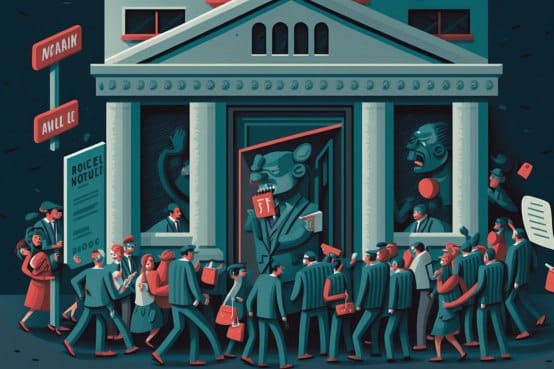
Understanding Bank Runs: Causes, Examples, and Prevention Measures
Commercial banks, hedge funds, and insurance businesses have significant uncertainties. Still, Americans trust financial institutions with a proven track record. When choosing a bank, customers evaluate account types, home loans, interest rates, certificates of deposit, insurance, financial planning services, the bank’s net worth, year-over-year profits, and reliable partnering companies.
Researching a bank’s stability before doing business with them doesn’t protect money management. Financial crises or investment mistakes may harm a financial institution’s solvency beyond management’s control. A tiny financial management error may damage a financial firm. This guide describes how big depositors and retail customers behave when a financial organization is about to fail. Bank runs occur when depositors relocate their money to a safer bank or keep it in cash. These funds are sometimes used to buy gold and silver.
Bank run explained
A bank run occurs when many clients remove their cash from a financial institution owing to its probable failure. Financial reports leaked memoranda, or management changes might all be factors causing this instability. A bank run is a panicked attempt to rescue one’s assets. Withdrawals in extreme situations surpass the bank’s available funds.
What occurs in the event of a bank run?
A bank run happens when people rush to take money from a bank out of fear or panic. If the bank does not have enough funds to meet the demand for withdrawals, it may go bankrupt. Banks must have a certain amount of money on hand for daily withdrawals, but an unexpected rise in demand might deplete their cash reserves. Banks may seek capital from other banks or the central bank to handle the issue or sell assets at a cheaper price.
The causes of a bank run
Bank runs are often sparked by fear, which various circumstances may generate, such as financial reports, unsuccessful investments, and the failure of collaborating corporations. Customers often withdraw cash when a bank’s share price or profit declines significantly. Commercial banks, giant corporations, and venture capitalists often orchestrate bank runs, causing panic among ordinary consumers who mistrust the afflicted financial institutions.
Silent Bank Run
A silent bank run occurs when customers withdraw funds electronically without physically visiting the bank. Many customers use non-physical withdrawal methods like ACH and wire transfers in today’s banking system. Although banks don’t need to scramble for cash during a silent bank run, the impact on the struggling bank is still significant.
Examples of Bank Runs
Bank runs, where individuals remove their money from financial institutions, initially appeared during the 1929-1939 Great Depression. Over 500 banks have failed due to bank runs since the 2008 Global Financial Crisis. The failure of Silicon Valley Bank, which saw the second-largest bank run in history, and the failures of Washington Mutual and Wachovia Bank, are two significant instances. Various circumstances, including weak market conditions and adverse financial reports, may trigger bank runs.
Bank run prevention
Mitigating steps early in a crisis may avert bank runs. A bank may hinder transactions by limiting withdrawal amounts or intentionally creating technical issues with online transactions. The bank can get short-term finance and satisfy customers. Electronic commerce is internet sales. Insurance deposits guarantee customers a certain amount of money if the bank fails. The FDIC covers deposits in licensed banks up to $250,000 per depositor. Finally, non-callable term deposits may be withdrawn after a certain period with interest. Additional withdrawals help banks avoid bankruptcy.
Conclusion
Customers like stable, trustworthy, and transparent banks. Thus, avoid banks without insurance or questionable financial histories. Customers may prevent losses by keeping their deposits under the insurance limit. Poor fund management or external events may cause financial organizations to fail, usually beyond their control.
Bank runs don’t cause all bank collapses. Credit and liquidity crises brought down Lehman Brothers, AIG, and Bear Stearns.




